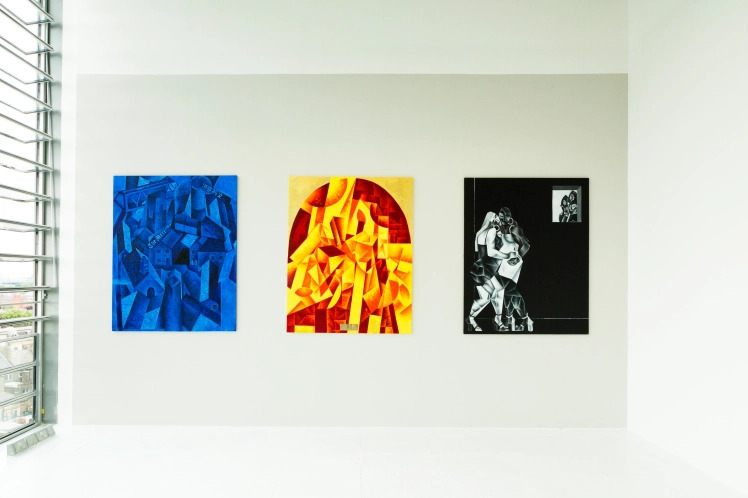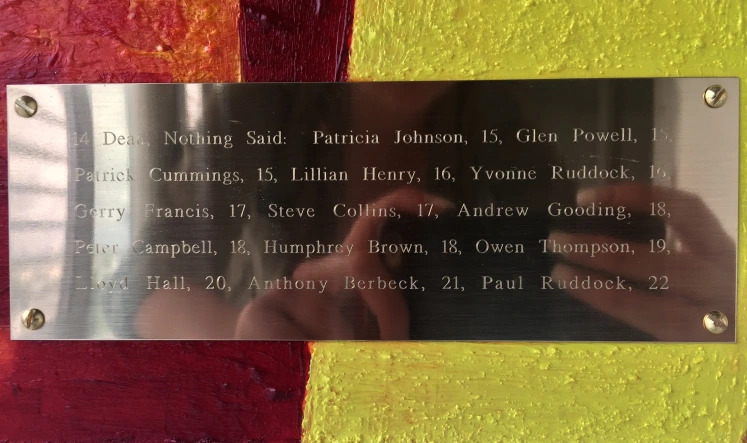Colours of Memory
by Ella Jones-Moore
9 October 2017
Originally published in our Old Blog.
In the early hours of Sunday 18 January 1981 a fire broke out on 439 New Cross Road, killing 13 young black Londoners as they were celebrating Yvonne Ruddock’s – one of the victims – birthday. One survivor died nearly two years later, bringing the official death count to 14. Concerns about racism had been running high in the area due to the active presence of the National Front. More importantly, several racially motivated arson attacks had already taken place in the London Borough of Lewisham. Initial suspicion within the local community as well as the police was that the birthday party had been firebombed but the crime has never been solved and those responsible held to account.
Artist Ella Jones-Moore portrays this tragic history in a new triptych called ‘Now and Then, Here and There’ that is on permanent display at Goldsmiths. She talks with Les Back about her work and the importance of keeping these struggles for justice alive.

Les: Could you tell us how came to choose the subject of your three paintings about the New Cross Fire?
Ella: With the triptych ‘Now and Then, Here and There’ depicting the New Cross Fire, I wanted to explore what has or has not changed, ‘now’, since ‘then’, and what it meant to depict ‘there’, ‘here’ in Goldsmiths. I wanted to portray the New Cross Fire to confront an integral part of not just local but national history and race relations, which took place right here on Goldsmiths’ doorstep. It was also a sort of confrontation on the lack of conversation surrounding race and class in current art teaching and practice, despite our location, with the focus on Post-Modern theories surrounding gender and sexuality. For me, it was a statement to put the New Cross Fire in the degree show saying we should still be talking about this, these issues have not gone away.
Whilst I have previously painted wider socio-historical events such as The Battle of Lewisham, my work often explores the experiences of my friends and I, growing up in South East London in multi-racial friendship groups, where race at once does and does not matter. As a white girl growing up and within a black group of friends my work explores the contradiction between the conviviality implicit in our relationships and the wider implications of our contrasting structural positions within society. My initial ideas in portraying the New Cross Fire were to commemorate and honour a largely unknown event in our local history, however in the end it did also come to represent all these contradictions, conflictions and convivialities which take place in inner city London areas like New Cross – how could it not, a white girl painting an attack on the black community?
Les: I know you grew up in Lewisham do you think that young people locally are aware of this history?
Ella: Not at all, which is why I felt it was important to depict the New Cross Fire and present it in New Cross to the public. It wasn’t until I came to Goldsmiths and spoke with a friend to whom I went to school with who was studying History here and writing her dissertation on the New Cross Fire, when I actually was made aware of the event. Through her I was put in touch with tutors, lectures and events run by the History and Sociology departments and realised there was a whole discourse surrounding the event and its importance in affecting not just local but national race relations. I’ve been educated in Lewisham from nursery to further education and had never been taught nor made aware of the New Cross Fire and nor had anyone else I grew up with. Whilst we had ‘Black History Month’ we were always taught about the Civil Rights Movement, Martin Luther King and Rosa Parks, but not about the struggles which took place on our doorstep and just a decade before we were born. To see the images of thousands of people marching on New Cross Road, on the roads we walk everyday, to protest racism on not just the Black People’s Day of Action but the Battle of Lewisham too, was mind blowing. One of the reasons I felt able to depict this event without feeling like I was depicting the ‘Other’ was because it is a shared local history we all are part of in some way.


Les: I really love the scene of the dance in the first painting and the image of the police officers peeping in the window, could you tell us something about the process behind of how your chose those scenes?
Ella: The image of the two women embracing actually came from a dream I had at a period of time during the painting process where I had hit a brick wall. After having presenting the New Cross landscape and the fire in very abstract ways I knew I wanted to end the series on the human experience, the aftermath and the grief. However, I struggled with the idea of trying to portray somebody else’s pain. How could I, a white woman, depict something I wouldn’t have been in the position of feeling? It would always feel like I was ‘othering’ or being exploitative in some way. I struggled for many weeks with this and couldn’t think of a way around it. Having done reading and research and the actual painting for some months, I was submerged in the subject so much so that one night I had a dream about it. The dream was about my best friend Gemma, who is black and with whom I grew up, livin’g in the area since we were in nursery. In the dream we were in our primary school when someone threw a fire bomb, and the school went up in flames. I looked everywhere for her and couldn’t find her. Somehow I ended up outside of the school, watching everything fall apart, knowing she was in there somewhere. She ended up emerging from the flames and we ran into each other’s arms, however the fear and despair I felt was indescribable and incredibly real. I woke up in a sweat.
The dream made me think about the New Cross Fire in relation to myself and my friends, as a white woman growing up in a black friendship group, having been to countless house parties, not feeling any different from them, however at the same time, being in a very different position. It made me think, where would Gemma have been, inside? Where would I have been, outside? The two policemen in the window were used to present the role of the police in the event but also to present an ambiguity as to whether they were on the outside looking in at the two women, or inside the aftermath, looking out at them. The image of the two women clinging to each other was taken from an image of Gemma and I at a club, laughing and clinging to each other in a drunken embrace. I used this image to illustrate the contradiction between the conviviality implicit in the two friends embrace, and the reality of black and white race relations; the difference in the gaze between the policemen and the black figure, and the policeman and the white figure.

Les: The last portrait of the city in mourning is incredibly powerful and has that terrible beauty that Yeats talked about – do you think the city is still blue and haunted?
Ella: I’m honoured you say that as it was my absolute aim to produce something beautiful which I don’t think I had achieved before, not only because I felt the subject matter deserved to be depicted with time, care and beauty, but also because I believe beauty can exist along side terror, destruction and pain. South London, particularly Lewisham, encapsulates ugliness in both its past and present; there is always an aura of mourning and loss which seems to continue whether it be the New Cross Fire or the countless victims of knife crime dying on our streets every year, both perpetual symptoms of a fractured and racist society. However, to me, there is still nothing more beautiful than walking down the Old Kent Road towards New Cross at dusk when the sky turns an electric blue and the streetlights glow red and orange. Like the fire, in all its destructiveness, it can also be very beautiful. It was this contradiction I wanted to portray. Because although the history of our area is tainted and ugly, growing up we all had a great pride in being from Lewisham, which we called ‘blue borough’.
Les: Could you tell me a few things about the Warden’s award, some biographical details and just some details about what you are doing now.
Ella: I was born, raised and educated here in Lewisham and have just begun my MA at Goldsmiths after completing my BA earlier this year. I was honoured the Warden chose my piece to be added to the Goldsmith’s collection and hung on the University walls especially because of how personal the content is to both myself and the local area. Hopefully people will read the plaque, and the names of those lost will be re-accounted for and remembered. Perhaps people will wonder what it is about and find out about it, opening up conversations about now and then, here and there. The main thing is that the New Cross fire is visually represented here in Goldsmiths and accounted for as part of our shared local history, amongst all the great written and communicative work other departments are doing to reflect on and discuss those tragic events which unfolded on our doorstep.
︎ Images: courtesy of Ella Jones-Moore.

